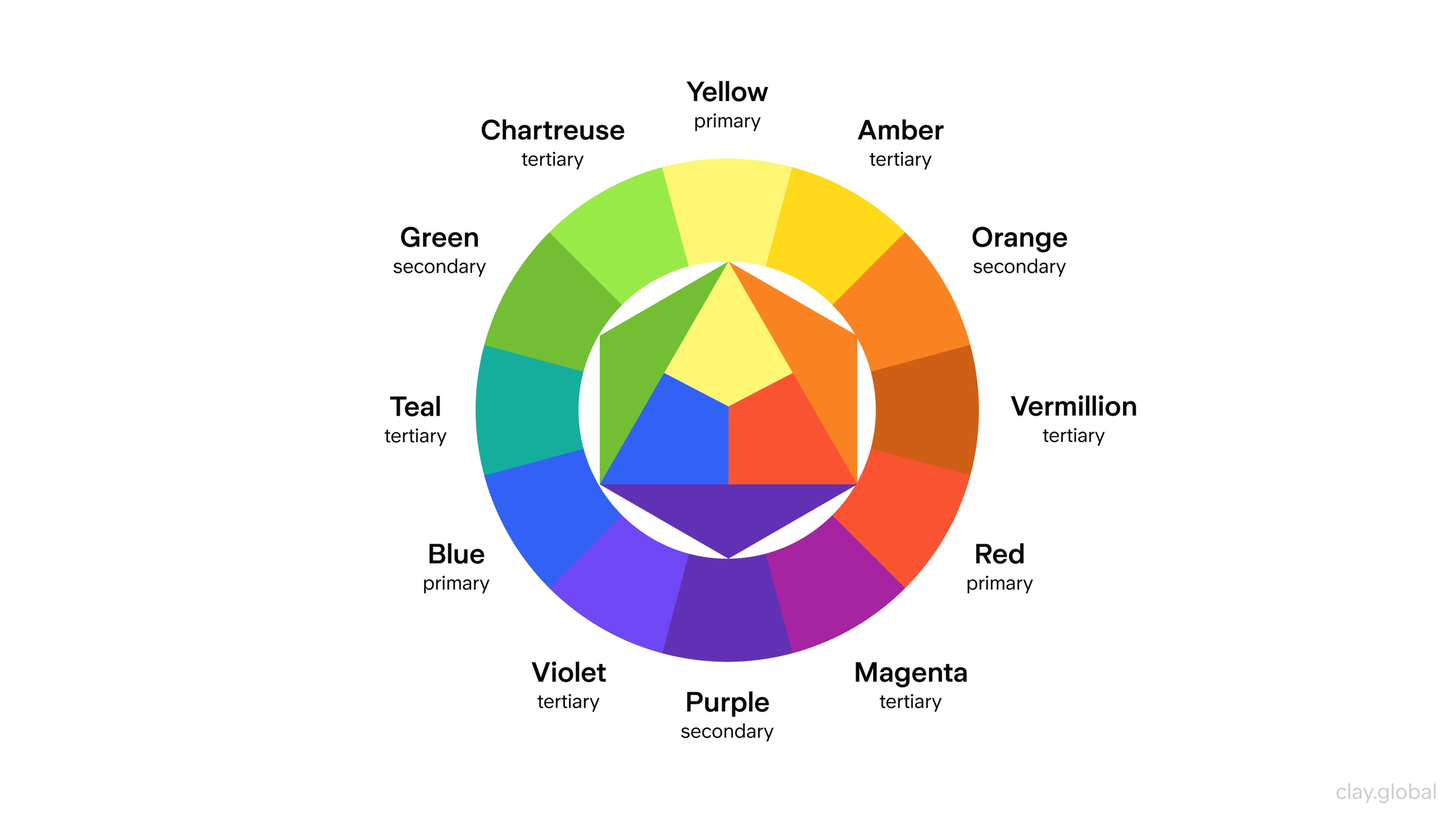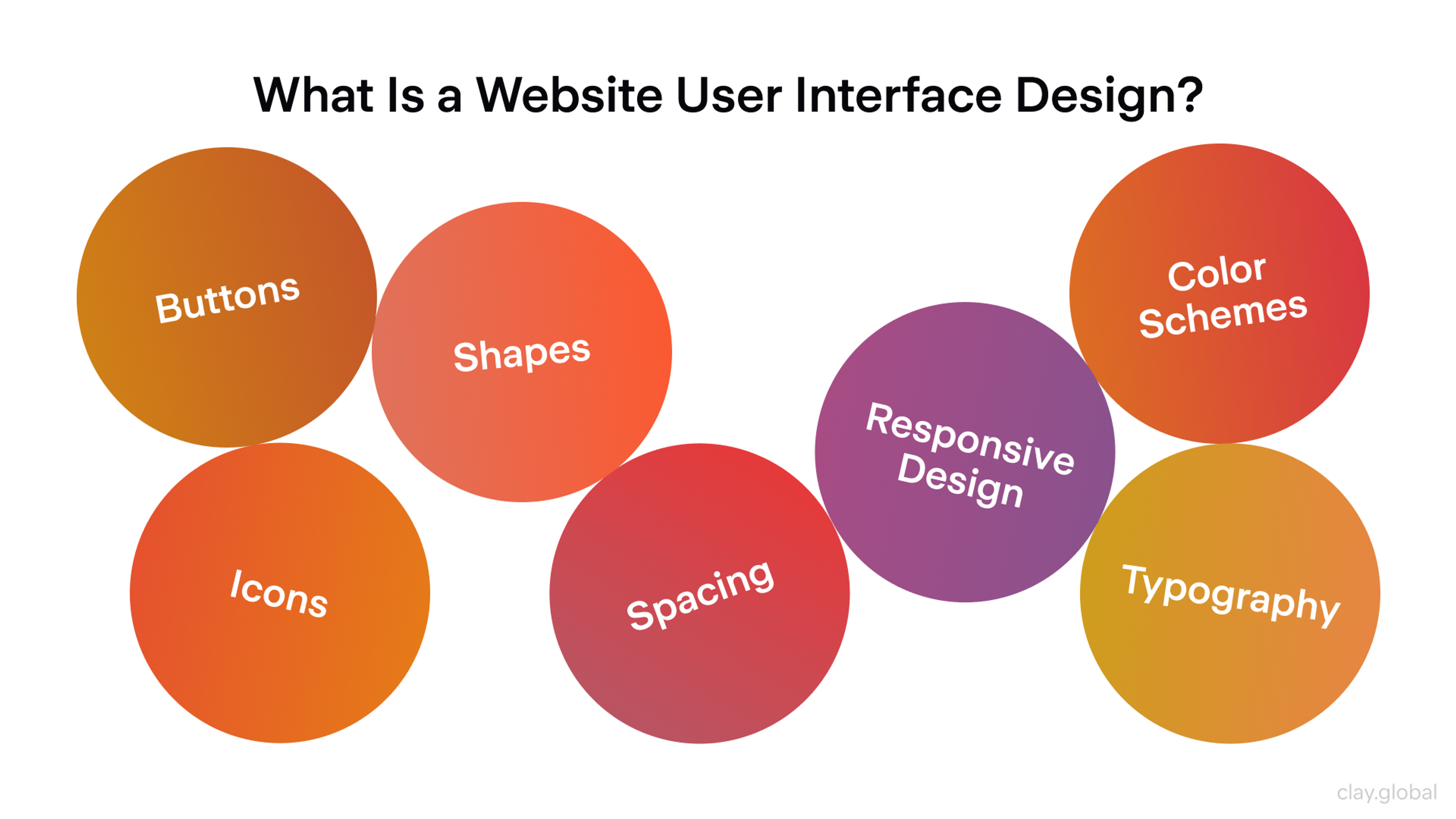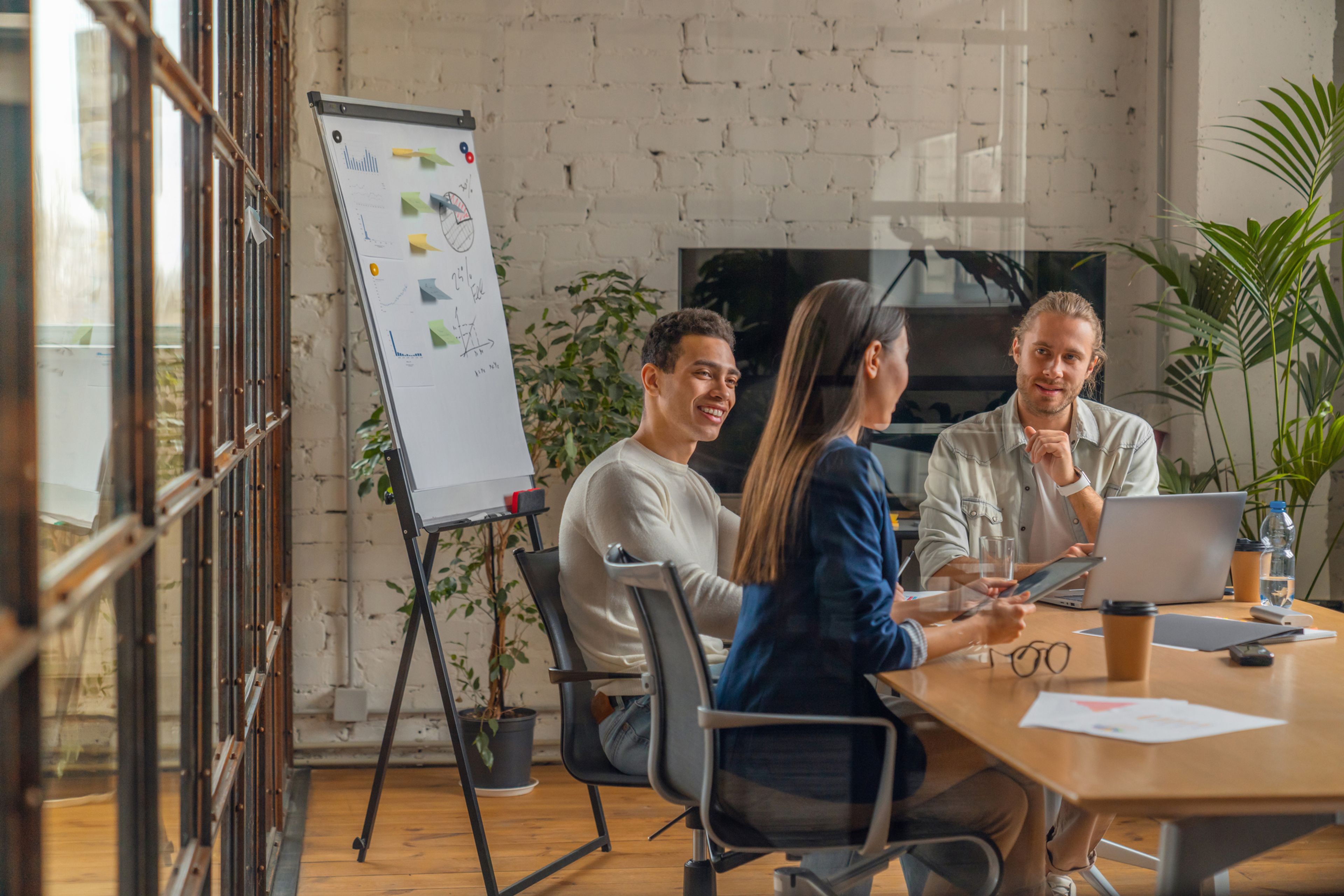Good UI makes or breaks small-business outcomes. When design works, it becomes invisible, and everything functions as intended. Thoughtful interface choices bridge business goals and customer needs, transforming them into clear, actionable steps that drive results.
Most small businesses chase visual appeal alone. They miss the deeper psychology driving user behavior. The best interfaces blend brain science with systematic research and user-focused thinking. This creates experiences that feel natural and effortless.
This article combines established psychology research with practical small business strategies. You'll learn how to design interfaces that work with human thinking, rather than fighting against it.
Design agencies can also help you.
UI UX Elements by Clay

What Is UI Design?
UI design creates the visual and interactive elements people use on websites and apps. It shapes layouts, typography, colors, and every element users touch or see.
The goal is to create interfaces that feel intuitive and deliver a positive experience. A UI designer is responsible for shaping these elements, ensuring both aesthetics and usability are addressed.
UI designers balance form with function. They create interfaces that look good and work even better. This balance keeps users engaged and satisfied. Well-executed UI designs are the result of achieving this harmony between appearance and usability.
In summary, user interface design is crucial for creating digital products that are both visually appealing and intuitive to use.
Why UI Design Matters for Small Businesses
UI design has a direct impact on how people interact with your business online. Strong design builds trust and enhances credibility. It makes navigation easy and information accessible. Users feel confident engaging with companies that invest in quality design.
Good UI design increases conversion rates and customer satisfaction. It creates lasting loyalty through positive experiences. Your interface often provides the first impression of your business. For designers, a strong portfolio of UI work is essential for demonstrating their skills and creativity, which helps them secure a job in the field.
Key Principles of Effective UI Design
Several core principles govern effective interface design. These principles ensure your interface serves users well. Key elements of effective UI design include typography, color schemes, navigation, icons, buttons, and microinteractions.
- Clarity forms the foundation. Users should be able to find what they need quickly and easily. Clear icons, simple language, and intuitive navigation remove confusion. Every element should communicate its purpose instantly.
- Visual appeal keeps users engaged. High-quality graphics and thoughtful typography create inviting experiences. Attractive interfaces capture attention and maintain interest throughout the visit. The use of well-designed UI elements, such as buttons and icons, enhances visual clarity and usability.
- Consistency builds familiarity across your interface. Fonts, colors, and element placement should follow predictable patterns. A consistent color scheme helps build understanding and unifies the design, making the interface feel cohesive.
Color Wheel Illustration by Clay

Visual Psychology Principles for Small Business UI
Visual psychology explains how people perceive and organize information. Understanding these principles helps create unified, easy-to-understand interfaces.
The art of UI design plays a crucial role in shaping visual perception, using aesthetic choices to enhance how users interpret and engage with interface elements.
Gestalt Principles: Proximity and Grouping
The Gestalt principle of proximity suggests related elements belong together. Position connected items close to each other. Separate unrelated elements with a space. This principle helps users understand relationships without labels.
Grouping related information reduces mental effort. Users quickly scan grouped elements and focus on relevant sections. Poor grouping creates confusion and requires more effort to understand the content.
Strategic spacing creates invisible boundaries. White space organizes information without adding visual clutter. Well-used space makes interfaces feel less crowded while improving comprehension.
White Space Illustration by Clay

Gestalt Principles: Similarity and Pattern Recognition
Similar elements should look identical. Different elements should look different. This similarity principle enables users to recognize patterns and understand functionality more quickly. Consistent button styling and color usage create predictable experiences.
Pattern recognition speeds up interaction by leveraging learned behaviors. Once users understand one part of your interface, they apply that knowledge everywhere. Consistent patterns reduce learning time and build user confidence.
Breaking patterns intentionally draws attention to essential elements. Strategic pattern changes, such as unique colors for primary actions, guide user focus while maintaining overall consistency.
Gestalt Principles: Closure and Completion
People naturally complete partial shapes and fill in missing information. This closure principle enables clean designs that avoid clutter and maintain a clear aesthetic. Implied lines and strategic negative space define areas without heavy visual elements, creating a sense of space and depth.
Closure also applies to user workflows. Users expect logical completion of started processes. A progress indicator is a feature that supports this principle by helping users understand their position in complex workflows. They know what comes next without confusion.
Understanding UI Design Psychology
Excellent UI design starts with understanding human thought and information processing. Brain science provides the foundation for creating natural interfaces that reduce mental effort. A structured design process is also essential, as it guides designers through each phase to ensure effective, user-centered UI.
What Makes Interfaces Intuitive
Intuitive interfaces align with users' mental models. People carry internal expectations for how things should work. When design aligns with those expectations, users can easily navigate and accomplish tasks without consciously focusing on the interface.
Mental models develop from previous experiences and cultural background. Successful small business interfaces use familiar patterns while introducing innovation gradually. This balance helps users feel comfortable while making your brand memorable.
Understanding mental models guides better design decisions. If users expect shopping carts in the top right corner, placing yours elsewhere creates friction. Respect core expectations while improving functionality to create memorable experiences.
What Is a Website User Interface Design by Clay

Managing Mental Effort
Cognitive load theory explains the mental effort required to use an interface. Research on human information processing identifies limits to mental resources. A high cognitive load can frustrate users and cause them to leave. Effective UI design systematically reduces this burden.
Clear visual hierarchy guides attention naturally. It helps users process information in a logical sequence. A well-designed hierarchy utilizes size, color, contrast, and spacing to create clear information pathways. Users immediately grasp what matters most on each page.
How Design Elements Suggest Their Function
Interface elements should suggest their function. Buttons look clickable. Sliders appear draggable. Input fields clearly accept text. These visual cues are called affordances.
Visual cues help users understand interface capabilities without instructions. Effective cues combine shape, color, shadow, and positioning to communicate function clearly and capture the user's attention, making it easier for users to notice and interact with essential elements. Poor cues force users to guess how elements work.
Digital cues differ from physical ones but follow similar brain principles. Users learn digital conventions through repeated exposure to them. Respecting these conventions while adding subtle improvements creates interfaces that feel familiar yet polished.
Information Architecture for Small Business
Information architecture determines how users find and understand content. Placing navigation elements on the left-hand side is a common practice that enhances usability and enables users to scan and access key sections easily. Good architecture makes complex information feel organized and straightforward.
Content Organization Strategies
Logical organization helps users build accurate mental pictures of your business. Start by understanding user goals. Organize content around those objectives rather than internal business structure.
Research methods, such as card sorting, help validate organizational approaches. These techniques reveal how your target audience naturally categorizes information. This understanding leads to more intuitive navigation structures.
Hierarchical organization works well for most small business websites. Use clear categories and subcategories. Consistent backgrounds help visually separate categories, making it easier for users to distinguish between different sections. Consider content that spans multiple categories and provides numerous navigation paths to the same information.
11 Types of Website Content by Clay

User Flow Mapping and Task Analysis
User flow mapping illustrates how users navigate through your interface to achieve their goals. These flows reveal friction points, unnecessary steps, and opportunities for improvement. Start with your most important user tasks and map ideal workflows, paying close attention to the specific user actions taken at each step.
Task analysis breaks down user goals into specific steps. This process identifies where mental effort increases or confusion occurs. Understanding task complexity helps you design appropriate interface support for each step.
Consider both ideal path flows and alternative scenarios. Users often do not follow the intended paths. Design for alternative routes and recovery from mistakes. Flexible navigation helps users stay on track even when they deviate.
Navigation Design Psychology
Navigation serves as a wayfinding for digital experiences. Effective navigation reduces mental effort by providing clear location awareness and obvious next steps. Users should always be aware of their location and know how to reach their destination.
Certain navigation features, such as clear menus and responsive layouts, are considered default in modern UI, supporting device adaptability and accessibility as standard expectations.
Breadcrumb navigation helps users understand their location within larger site structures. The search functionality provides an alternative navigation option for those who prefer direct access. Multiple navigation methods accommodate different user preferences and mental models, allowing for a more personalized experience.
Website Navigation Example by Clay

Building Trust Through Design
Trust has a direct impact on conversion rates and customer loyalty. Design elements build or erode trust through every interaction.
Achieving design excellence ensures that interfaces meet the highest standards, which significantly contributes to building user trust and confidence. Understanding trust psychology helps create interfaces that feel credible and secure.
Visual Credibility Factors
Professional visual design immediately communicates business credibility. High-quality imagery, consistent typography, and polished interface elements suggest attention to detail.
Credibility is created through intentional design choices that align with the brand's values and audience expectations. Poor visual design raises questions about business competence.
Typography Illustration by Clay

Current design trends signal that businesses stay updated with technology and user expectations. However, trendy elements should support functionality rather than distract from core goals. Balance contemporary looks with timeless usability principles.
Transparency and Communication Design
Clear communication fosters trust by providing honest information and using straightforward language. Transparent pricing prevents unwelcome surprises. Progress updates reduce uncertainty and demonstrate reliability.
Authentic social proof, such as customer reviews, enhances credibility and trust. Feedback from the community further reinforces trust by showcasing real user perspectives. Real testimonials show genuine user experiences. Avoid fake or overly polished reviews that trigger skepticism.
Security and Privacy Communication
Security design signals protection through subtle elements. SSL badges and privacy policy links communicate safety. These signals matter even when users are not actively aware of them.
Security standards are shaped by best practices from around the world, ensuring that sites meet global expectations for user protection.
Respect for user data builds trust. Transparent policies and minimal data collection demonstrate consideration. Avoid excessive trust messaging. Confident, professional design speaks louder than repeated security claims.
Design Systems for Small Business
Small businesses benefit from simplified design systems that improve quality without requiring extensive resources.
Component-Based Thinking
UI components are reusable interface elements that maintain consistency and visual coherence throughout an application. Button styles, form elements, and content blocks become building blocks for larger interfaces.
Component thinking helps small businesses maintain visual consistency across different pages. The ability of designers to create practical, reusable components is crucial for building scalable and cohesive user interfaces.
Consistent components convey a professional image and reduce mental effort. They create predictable interaction patterns throughout the user experience. Users are familiar with what to expect from familiar elements.
Scalable Design Patterns
Design patterns solve common interface problems in proven ways. Small businesses benefit from established patterns that users already understand. Add unique brand elements for differentiation while maintaining familiar structures.
Pattern libraries collect reusable solutions for navigation, forms, and content display. These libraries speed up design decisions while maintaining consistency.
Design patterns play a significant role in building scalable UI systems, ensuring that interfaces remain consistent and efficient as your business expands. Start with core patterns and expand systematically as needs grow.
Best Examples: Websites with Good User Interface
Smaller businesses with great UI design are distinguished by their appealing, effortless, and engaging user experiences. Here, I will present a few well-known small businesses that do well in UI design and show that interfaces do matter when it comes to usability and business growth.
Joe & The Juice
In our work with Joe & The Juice, we created a visually appealing and user-friendly website that makes a strong first impression. We built trust with potential customers by strategically using colors, typography, and layout.
The clean and intuitive design allows users to navigate easily without searching for information. Additionally, including interactive elements enhances the visual appeal and increasing user engagement, of the website, making it more accessible and enjoyable for users.
Joe & The Juice Design by Clay
Blume
Blume is a skincare and wellness brand that favors a minimalist yet playful design for their shopping experience. For a small business that values branding and usability, the soft color palette, intuitive navigation, and interactive product pages are a perfect fusion of a tranquil experience.
Source: blume.com

Pipcorn
Pipcorn is a small yet growing snack brand with a simple UI design that provides an effortless, smooth user experience. The website highlights its products with bold visuals, large buttons, and easy checkout options. Users can easily discover and browse products in a seamless manner, which greatly aids in keeping them engaged.
Source: pipsnacks.com

Ugmonk
The boutique lifestyle brand Ugmonk has always drawn attention with its clean typography, breathtaking high-quality visuals, and intuitive interface, which portrays rest and comfort. Its product pages emphasize uncluttered design and ample white space for a premium yet accessible shopping experience that many greatly appreciate.
Source: ugmonk.com

Beardbrand
Beardbrand is a small men's grooming brand with bold branding and functional UI. It ensures customer engagement via an interactive product quiz, informative visuals, and smooth product navigation, making the products easy for customers to find.
Source: beardbrand.com

Partake Foods
Partake Foods focuses on creating snack products that are free from allergic reactions. They utilize simple fonts, easy-to-filter product labels, a universal design style, clear communication, and an overall very visual UI. All of these efforts strengthen its identity as a brand while still catering to a broader audience.
Source: partakefoods.com

FAQ
What Is UI Design?
UI design focuses on the visual and interactive parts of a digital product. It includes layouts, colors, typography, buttons, icons, and all elements users touch or see. Its purpose is to make interactions clear, intuitive, and visually appealing so users can complete tasks easily.
Why Is UI Design Important for Small Businesses?
UI design affects how users perceive your business within seconds. Clear, intuitive interfaces build trust, increase conversions, and make your website easier to navigate. A polished interface signals credibility, reduces frustration, and helps small businesses compete with larger brands.
What Makes a UI Intuitive?
A UI feels intuitive when it aligns with users' mental models, employs familiar patterns, and conveys functionality visually. A clear hierarchy, consistent design elements, and recognizable cues, such as buttons and icons, help users understand the interface with minimal effort.
How Does UI Design Build Trust?
UI design builds trust through professional visuals, consistent branding, readable content, and transparent communication. High-quality images, clean layouts, and clear navigation show reliability. Users feel safer engaging with businesses whose interfaces appear credible and well-maintained.
How Can Small Businesses Improve Their UI?
Small businesses can enhance their UI by simplifying navigation, using consistent colors and typography, organizing content clearly, and minimizing visual clutter. Testing designs with real users reveals problems quickly. Even minor improvements, such as clearer buttons or better spacing, can significantly enhance usability.
Read more
Conclusion
Strong UI design builds customer trust and drives business success. The principles covered combine psychology research with practical application. You now understand how mental models, cognitive load, and visual perception shape user experience.
Start small with high-impact improvements. Apply one Gestalt principle to your most important page. Simplify a confusing navigation menu using Hick's Law. Test button placement using principles of visual hierarchy. Small changes compound into significant improvements.


About Clay
Clay is a UI/UX design & branding agency in San Francisco. We team up with startups and leading brands to create transformative digital experience. Clients: Facebook, Slack, Google, Amazon, Credit Karma, Zenefits, etc.
Learn more

About Clay
Clay is a UI/UX design & branding agency in San Francisco. We team up with startups and leading brands to create transformative digital experience. Clients: Facebook, Slack, Google, Amazon, Credit Karma, Zenefits, etc.
Learn more


